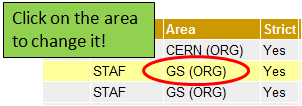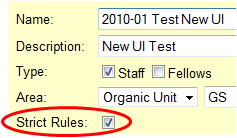
SMT Basic Concepts
The Area of The Simulation
When you create a new simulation, you are presented with the following dialog:

In this dialog, you specify the name and the description of the simulation and you can also say whether you want to simulate only STAF or FELL or both of them. Furthermore, you select the area of the simulation.
Depending on the access rights you have to HRT and SMT, a new simulation is either created with all of CERN as its area, or the department over which you have access.
You can change the area of the simulation by clicking in the Area or Area Type column in the Simulation List. By clicking in any of these columns you will be asked to enter the area type and the area itself.

SMT supports the following area types:
-
Organic Units
-
PPA units
-
Projects
Selecting only the area you need can substantially reduce the time needed to re-execute the simulation. Note though that regardless of which area you choose, you will never be able to see people to which you do not have access.
As an example, assume that there is a project X which involves STAF from both department A and department B. Now also assume that you have access to see people in department A but not in department B. Should you then create a simulation who's area is project X, then you will see only those people that concern department A when making reports on that simulation.
Costing Organic Unit versus Attachment Organic Unit
Normally the organic unit that a person is attached to is the same as the unit bearing the costs for that person. However if the budget code which is used to bear the costs of the person is attached to another organic unit or he is recharged to a team code using a recharging code, then the Costing Organic Unit is different from the Attachment Organic Unit.
In all SMT screens you can filter (or group by if applicable) on both types of organic units.
FTE's versus Presence, Salary versus Cost
The results produced by SMT contain several different figures such as FTE, Presence, Salary and Cost. These figures can be selected as columns in the main reports provided by SMT. Below follows a description of each of these figures.
FTE (Full Time Equivalent)
The amount of time the person is paid for. A value of 1.0 means this person
is paid for full time. If the person is split over multiple budget codes
then the FTE value is split over these budget codes. The sum of FTE's for a given time period should always equal 1.0 for
a person working full time.
A person working part time will have his FTE value reduced proportionally.
Presence
Normally the presence equals the FTE. However, in certain cases a person may be paid by CERN but still not doing any work for CERN. For
example when being on paid special leave, some pre-retirement schemes etc.
In these cases, the presence figure will be less than the FTE figures (and will normally be 0.0).
Salary
The salary is the reference salary given by a person's position in
the CERN salary grid multiplied with the FTE figure. Thus, when a person is
paid by multiple budget codes the salary is also split over these codes.
Cost
The cost represents the actual cost of the person. In SMT the cost
is calculated by applying an Overhead Factor to the salary of a person. This overhead factor is supplied by the CERN finance department.
Note: The overhead factor(s) mentioned above are normally adjusted several times per year by the finance department. A separate factor can also be given for each year of the simulation. When an adjustment of the overhead factor is done by the finance department this will be seen as a sudden change (normally an increase) in the global cost of the simulation even though the simulation has not been changed by the user.
Strict Application of Rules
You can choose between applying strict rules and loose rules to your simulation. You do this by clicking on the Strict Rules column in the Simulation List.

When using strict rules, the simulation will not accept certain data, for example such as:
-
A termination date of an LD contract that results in more than 6 year running time for that contract.
-
An indefinite contract appointment after the first 4 years of a 4+2 contract,
-
An indefinite contract appointment after the first 3 years of a 3+3 contract unless it is first extended with a second period.
-
A new termination date on a contract that has a confirmed departure date in the HR database or a fixed contract duration.
HR Data
SMT will automatically pick up officially registered data from the HR database such as future contract amendments, costing changes etc.
In addition, it will automatically pick up any published posts that have not yet been filled and fill these posts 8 months from the publication date provided that this will result in the recruitment taking place at least 3 months from today's date.
User Data (known by the user but not yet in the HR database)
You - as the user - can add data that is known to you but not (yet) officially registered in the HR database. See the pages on Base Data Editor, Contract Data Editor, Costing Data Editor and Recruitment Data Editor.
Simulation Parameters (probabilities)
![]() Certain
aspects of the simulation, especially the rules that rely on statistical
probabilities, are controlled by a set of Simulation Parameters
which can be accessed via the Parameter Editor (picture below).
Certain
aspects of the simulation, especially the rules that rely on statistical
probabilities, are controlled by a set of Simulation Parameters
which can be accessed via the Parameter Editor (picture below).
Each parameter can be enabled or disabled by clicking on the Disabled column which will toggle the disabled state on and off.

By selecting a line (left-click on the name or description of the parameter) and then clicking on the edit icon or by choosing the entry "Edit Parameter Values" from the context menu you can modify the statistical probabilities that controls the simulation rule in question.
Note:
-
Probabilities are expressed in a number between 0.0 and 1.0 where 1.0 equals a 100% probability.
-
Some parameters can not be changed by the user. Which can columns can be edited and which not is indicated by the value of the last column "User Edit Allowed" in the parameter list.
-
The probabilities are expressed in relation to the eligible population and not the total population. Example, a 30% probability of getting a band change between band b and c refers to the population that are in the correct transition point between band b and c and not to 30% of everyone in band b.
Execution and re-execution of a simulation
![]() A
simulation must be executed the first time a simulation has been created
and re-executed when the simulation parameters have changed.
A
simulation must be executed the first time a simulation has been created
and re-executed when the simulation parameters have changed.
Executing a simulation means that the simulation engine will load the most recent data for each individual in the population from the HR database, the simulation parameters as well as any specific data entered by the user and iteratively apply the rules of the simulation in order to project the current population from today to 10 years in the future.
Execution of a simulation can be done manually by clicking on the cog-wheel icon in the simulation list or Base Data Editor (or any of the other editors).
In addition the re-execution of a simulation is done automatically whenever a report is executed based on a simulation where the user-entered data has changed.
In contrast, a simulation is not automatically re-executed due to changes in the HR database (to scan for changes in the full HR database is prohibitively expensive/time-consuming and thus not practical). Thus, a simulation that has been left untouched for an extended period of time must more than likely be re-executed manually in order to reflect the current state of HR data.